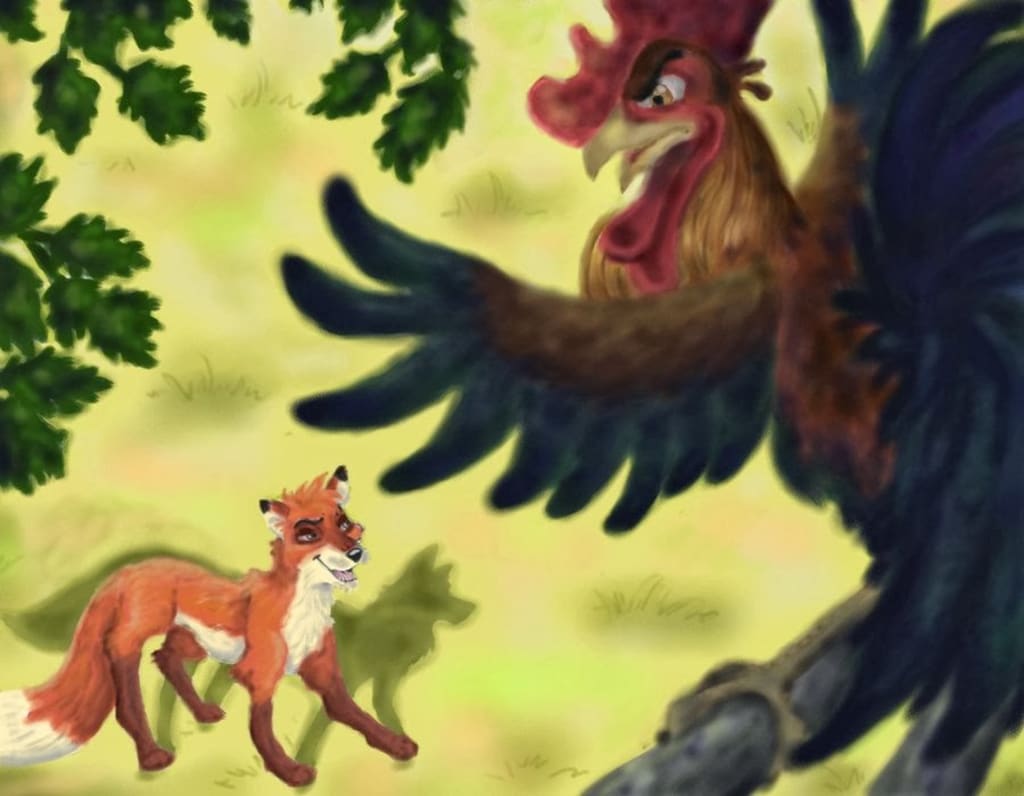The Nun's Priest's Tale, by Geoffrey Chaucer
A mock-heroic Canterbury Tale that is widely regarded as one of Chaucer's best

The Nun’s Priest is one of the pilgrims in Chaucer’s Canterbury Tales of whom we know virtually nothing before he tells his tale. In the General Prologue we are told that the Prioress has “another nun” with her and “three priests”. When we reach the point at which the Nun’s Priest is introduced, there is no mention of the other two.
The short prologue of his tale consists mainly of the epilogue of the preceding tale, namely that of the Monk. This has been a long series of accounts of people who have fallen from high estate, starting with Lucifer and including rulers closer to Chaucer’s time. The Knight has interrupted the Monk, saying that he would rather hear about people who have risen than fallen, and the Host asks the Monk to tell another, more acceptable, tale. However, he refuses, and so the Nun’s Priest is asked instead.
Apart from agreeing to the Host’s request, and apologising should his tale not be considered “merry” enough, the Priest says nothing in his own prologue. All we learn about him is in the final line, where he is described as “this sweet priest, this goodly man, sir John”.
The Tale is an animal fable, similar in nature to the classical fables told by Aesop, which would have been very familiar to Chaucer’s real and fictional audiences. However, it is brought up to date, in medieval terms, by its use of concepts from medicine, astrology and psychology, in such a way that the Tale gives us an excellent window on the 14th century mind.
The Tale
We are introduced to an elderly widow, living a simple life on a small farm with her two daughters. Of particular interest is her cockerel, named Chauntecleer, who has seven hens in his harem, the most notable being Pertelote. It soon becomes clear that we are in a fantasy world here, because these “beasts and birds could speak and sing”.
One morning, Chauntecleer is not his usual perky self, and he tells Pertelote that he has had a bad dream, in which he was frightened by a strange dog-like creature, causing him to wake up groaning rather than crowing.
Pertelote has no sympathy for him, regarding his fear as pure cowardice, and declares that she can have no love for him any more. As hens go, she is clearly a highly-educated one, as she is able to quote the Roman writer Cato to back her case that dreams are the result of “bad humours” in the body, and that purging the body of all the bad stuff is the answer. Pertelote prescribes a list of readily available herbs that should do the trick. Presumably a 21st century hen would have recommended a “detox” programme!
Chauntecleer is not convinced, and quotes other authors who had a different line to that of Cato. In particular, he recounts a story about two friends who sleep in different inns, one of whom has a dream about the other being murdered and thrown into a dung cart. In the morning, he discovers that this is exactly what has happened in the night. The conclusion is that “murder will out”, and dreams are God’s way of ensuring that justice is done.
The well-read cockerel continues by recounting the tale of a man who warned a friend not to take a sea voyage, because he had had a dream in which he had been told that the ship would sink. His friend ignored the advice and was subsequently drowned when the ship foundered. Further examples follow, with the cockerel quoting Saint Kenelm, the Old Testament, and classical mythology, as sources testifying to the power of dreams.
In short, says Chauntecleer, you can forget all about your poisonous laxative herbs, because I’m not touching them. With that, he hops down from his perch and gets on with the business of the day, which is finding corn and doing what cocks are supposed to do when surrounded by willing hens.
Several weeks pass by, and, on a day when all the chickens are busy in the yard, a fox sneaks in and hides in ambush, waiting for an opportunity to pounce. Chauntecleer notices the fox, but, before he can escape, the fox tells him that he means him no harm, but only wants to hear him sing. Chauntecleer falls for the flattery and is grabbed by the fox.
As the fox makes off with the cockerel in his mouth, the widow, her daughters, and all the farmyard animals set off in chase after them. Even a swarm of bees gets in on the act. Chauntecleer tells the fox that, were he in the same situation, he would turn to face his pursuers and tell them to back off. The fox tells Chauntecleer that this is a good idea, but by opening his mouth to speak he allows the cockerel to escape and fly high into a tree. The fox tries to inveigle the cockerel back down, but he will not be caught a second time.
The Priest then ends his Tale by pointing to its moral, which is to “take the fruit and let the chaff be still”. In other words, concentrate on what is real and ignore all the falsities that might surround it, whether one is talking about dreams or flattery.
There is also a short epilogue to the Tale, in which the Host thanks the Priest for his tale and remarks on his appearance, which is the only description given of the Priest at any point. However, these remarks about how the Priest has “so great a neck and such a large breast”, and that, if he had not been a priest he would be very attractive to women, are very reminiscent of the words said by the Host to the Monk before the latter began his tale. It is possibly for this reason that Chaucer apparently wished to cancel this epilogue, by crossing through the text in his manuscript. The Tale, however, is made no better or worse for the epilogue being either included or omitted.
Discussion
Many people regard the Nun’s Priest’s Tale as being the best of all the Canterbury Tales, and it certainly represents Chaucer in top form. He has produced a story that is so imbued with wit, so cunningly wrought at all points, artfully blending mockery with sympathy and irony with understanding, that the traditional nature of the materials is lost sight of in the brilliant finish of the performance.
This is the first notable example in English of the mock-heroic, a format that allows triviality to be blown out of proportion by the inclusion of classical allusions and long digressions, after which, in the current example, the teller has to bring himself back to the plot. At one moment the characters are chickens in a farmyard, and the next they are reciting Latin texts. Chauntecleer becomes an educated gentleman, and Pertelote is a practical and rather disillusioned woman of the world. The net effect of mock-heroic is to point to the absurdity of human aspirations and concerns. They matter no more, says Chaucer, than the scratchings of chickens in the dirt.
As with all stories of this kind, there is meaning on all sorts of levels, and every fresh reading reveals new satires and witticisms. This commentator agrees with those who give the Nun’s Priest’s Tale a very high ranking amongst the Canterbury Tales of Geoffrey Chaucer.
About the Creator
John Welford
I am a retired librarian, having spent most of my career in academic and industrial libraries.
I write on a number of subjects and also write stories as a member of the "Hinckley Scribblers".






Comments
There are no comments for this story
Be the first to respond and start the conversation.